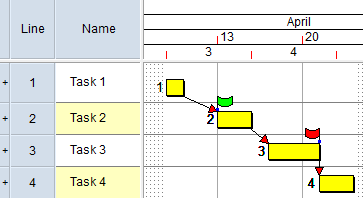'Hard constraints' quality metric
Use the 'hard constraints' metric to check the proportion of tasks that do not have Start On or Finish On constraint flags. These "hard" constraints should be avoided in a schedule as they can lead to inaccurate finish dates. A high proportion of tasks with hard constraints can indicate that a schedule has been planned with too little flexibility.
With the pass and fail boundaries set to 100.00%, this metric meets the requirements of CIOB stress test 5 (Hard constraints). With the pass and fail boundaries set to 95.00%, this metric meets the requirements of DCMA test 5 (Hard constraints).
In the following illustration, Task 2 has a Start On constraint flag and Task 3 has a Finish On constraint flag. These hard constraints mean that both links would fail this metric:

You can change the impact that this metric has on the weighted total result of a quality check by entering a factor by which the quality metric should be multiplied in the Weighting field. For the weighting to have any effect, a quality check must have more than one quality metric.
Pass and fail criteria
| Pass or fail? | Criteria |
|---|---|
| Pass |
A project passes this metric if the percentage of tasks that do not have a hard constraint is greater than or equal to the pass boundary percentage.
For example, if the pass boundary was set to 98.00%, a project would pass this metric if 98.00% or more of tasks did not have Start On or Finish On constraint flags. |
| Fail |
A project fails this metric if the percentage of tasks that do not have a hard constraint is less than the fail boundary percentage.
For example, if the fail boundary was set to 95.00%, a project would fail this metric if less than 95.00% of tasks did not have Start On or Finish On constraint flags. |
| Neither pass nor fail | If the percentage of tasks that do not have a hard constraint falls between the pass and fail boundary percentages, the result is neither a pass nor a fail, but somewhere in between. |
Default suggested settings
- Pass boundary: 98.00%. A project will pass this metric if 98.00% or more of tasks do not have Start On or Finish On constraint flags.
- Fail boundary: 95.00%. A project will fail this metric if less than 95.00% of tasks do not have Start On or Finish On constraint flags.
The following table shows whether some example projects would pass or fail this metric using these settings:
| Percentage of tasks with no Start On or Finish On constraint flags | Pass or fail? |
|---|---|
| 0.00% | Fail |
| 50.00% | Fail |
| 94.99% | Fail |
| 95.00% | Neither pass nor fail |
| 97.99% | Neither pass nor fail |
| 98.00% | Pass |
| 100.00% | Pass |
Suggested settings to meet the requirements of CIOB stress test 5 (Hard constraints)
- Pass boundary: 100.00%. A project will pass this metric if no tasks have Start On or Finish On constraint flags.
- Fail boundary: 100.00%. A project will fail this metric if any tasks have Start On or Finish On constraint flags.
The following table shows whether some example projects would pass or fail this metric using these settings:
| Percentage of links with no Start On or Finish On constraint flags | Pass or fail? |
|---|---|
| 0.00% | Fail |
| 50.00% | Fail |
| 99.99% | Fail |
| 100.00% | Pass |
Suggested settings to meet the requirements of DCMA test 5 (Hard constraints)
- Pass boundary: 95.00%. A project will pass this metric if 95.00% or more of tasks do not have Start On or Finish On constraint flags.
- Fail boundary: 95.00%. A project will fail this metric if less than 95.00% of tasks do not have Start On or Finish On constraint flags.
The following table shows whether some example projects would pass or fail this metric using these settings:
| Percentage of tasks with no Start On or Finish On constraint flags | Pass or fail? |
|---|---|
| 0.00% | Fail |
| 50.00% | Fail |
| 94.99% | Fail |
| 95.00% | Pass |
| 98.00% | Pass |
| 100.00% | Pass |
Does the metric force a project to be rescheduled?
No.
Suggested actions if a project fails this metric
If a project fails this metric, select the metric in the Quality Check Results dialog and click Show Failing Tasks to view the tasks that have failed the metric.
You could take the following actions to remedy the failing tasks:
- Remove Start On or Finish On constraints from tasks if they are not absolutely necessary.
- Replace Start On constraints with Start On or After constraints, if appropriate.
- Replace Finish On constraints with Finish On or Before constraints, if appropriate.
- Use links between tasks to determine the dates on which tasks must start and finish, rather than restrictive constraint flags.
Introduction to schedule quality checking
Setting a start or finish flag